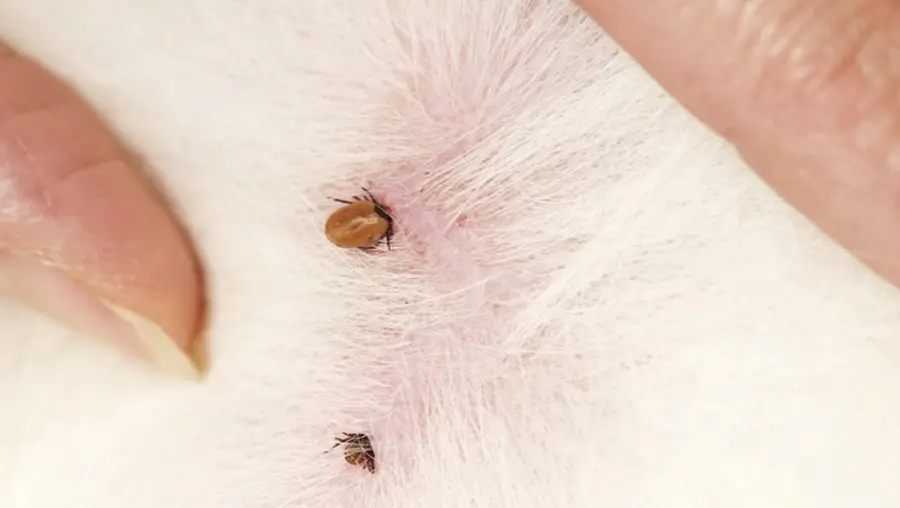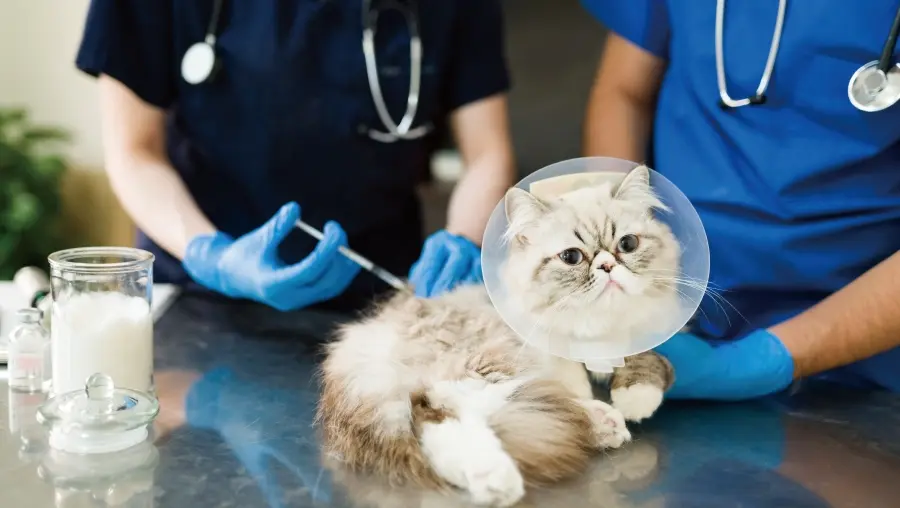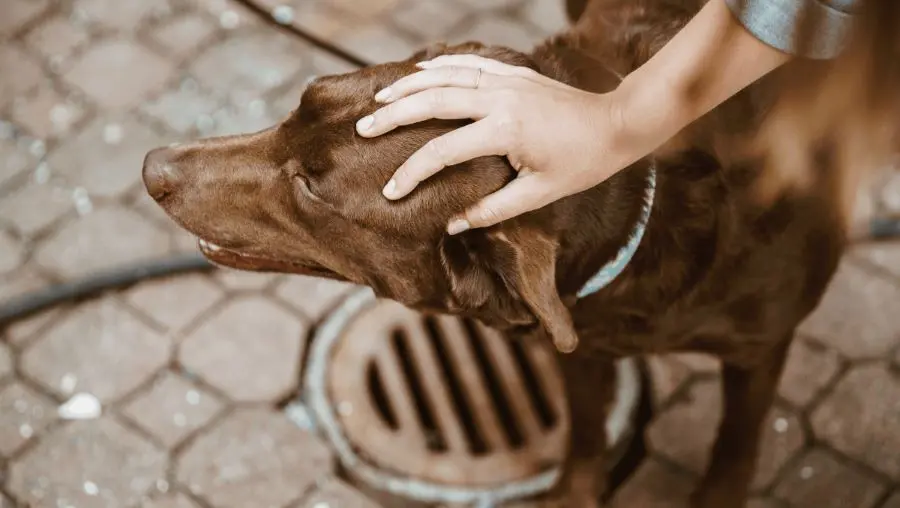Have you discovered a flat, grayish bug on your dog or cat that can’t be removed by pinching? Be cautious, as this could be the ‘flea’ that pet parents fear! Fleas are a dreadful and persistent type of external parasite that, once they latch onto a pet’s skin, can be difficult to remove. Attempting to forcibly remove fleas can lead to wound infections, but ignoring them can result in pets contracting internal parasites or blood-related diseases, which is very serious. It is important to note that if your pet has fleas, do not directly crush them, as their bodies are filled with eggs and sources of infection, which can endanger your pet and also affect you as a pet parent. **Extended Reading** Common parasites in cats and dogs, both internal and external! They can also be transmitted to humans, so pet parents must pay special attention! So, what should we do? In this article, we will inform pet parents of the following important steps to ‘eliminate and prevent fleas’: What are fleas? What are the symptoms of transmitting fleas? The transmission routes of fleas and why cats and dogs get infected with fleas? Fleas can easily lead to infectious diseases. What to do if there are fleas on cats and dogs? How to remove them? How to prevent dogs and cats from getting fleas? Common questions about fleas. How to eliminate fleas and bring back the smiles of our pets? Don’t worry, this article will guide you step by step! OPEN article table of contents: What are fleas? The life cycle of fleas! Common types of fleas. Common infectious diseases caused by fleas. The life cycle of fleas. How to check for fleas on cats and dogs? Symptoms of cats and dogs infected with fleas? The transmission routes of cats and dogs with fleas? Can they be transmitted to humans? Humans can also be infected with fleas! How to prevent cats and dogs from being infected with fleas? Method 1: Use of anti-parasitic drugs. Method 2: Check the bodies of cats and dogs after walks. Method 3: Regular health checks. What to do if there are fleas on cats and dogs? How to remove them? Step 1: Prepare a container to kill fleas. Step 2: Prepare tools for removing fleas. Step 3: Use tweezers to remove fleas. Step 4: Disinfect and check for any mouthpart remnants. Step 5: Disinfect your hands and tweezers. A small reminder: Do not use Vaseline or alcohol to remove fleas from cats and dogs. If the female flea is engorged, how to remove it? Summary: How to remove fleas from infected pets? Daily prevention rules! Common questions about fleas. What are fleas? The life cycle of fleas! Fleas feed on the blood of warm-blooded animals and firmly cling to pets, sucking a lot of blood and being difficult to remove. When fleas feed on blood, there is generally no pain, but because their mouthparts and submandibular plates are inserted into the host’s skin at the same time, they can cause local congestion, swelling, and acute inflammation. Fleas are also intermediate hosts for many internal parasites and infectious diseases, so if fleas are found on pets, it is necessary to go to the veterinary hospital for a blood test to check for other diseases, which is the most appropriate way to handle it. The following will introduce common types of fleas in Taiwan, the infectious diseases they bring, and their life cycles, starting with understanding fleas to learn how to eliminate them! Common types of fleas: To eliminate fleas, it is necessary to understand what they look like. There are more than a thousand types of fleas, and the most common in Taiwan are the following three: The most common infection type in Taiwan at present is the brown dog flea, which can transmit many blood diseases, and pet parents need to pay special attention! These three types of fleas carry different pathogens, and the common method is mostly blood transmission. When fleas bite animals carrying pathogens and then bite pets or pet parents, transmission may occur.
In the following short sections, we will introduce the common infectious diseases caused by ticks. Common infectious diseases caused by ticks include Lyme disease, babesiosis, canine ehrlichiosis, hepatozooniasis, etc. The detailed symptoms are as follows: Lyme disease (zoonotic): Both dogs and cats can be infected, and humans may also be transmitted. It can cause symptoms such as fever, vomiting, and diarrhea. In severe cases, it may even cause myocarditis and lead to death. After recovery, there may also be irreversible nerve damage (humans will develop rashes when they fall ill). Babesiosis: After babesiosis enters the dog’s body through tick bites, it will cause acute or chronic anemia, and in severe cases, it may even be fatal. The initial symptoms are fever, loss of appetite, decreased activity, and bloody or yellow urine, etc. Ehrlichiosis: After being bitten by ticks, the pathogen will reproduce in white blood cells, lymph, internal organs, and bone marrow, destroying platelets, blood cell regeneration function and the immune system, leading to organ damage. Common clinical symptoms are loss of appetite, anemia, weight loss, depression, fever and lethargy. Hepatozooniasis: There will be fever, listlessness, and emaciation. Anemia leads to pale mucosa, and increased eye and nose secretions can be seen. [Extended Reading] What should I do about dog eye secretions? Teach you to see if there is inflammation! The life cycle of ticks The reason why ticks are so可怕 is that their infectivity is very strong. As long as there is one tick on a cat or dog, there will be ticks everywhere in the home in less than a week, and even pet parents will be bitten… So why is the infectivity of ticks so terrifying? Let’s understand the life cycle of ticks! Hatching eggs When a female tick attaches to the host, it will be full of blood in about 1 – 2 weeks and immediately leave the host to lay eggs. A female adult can produce about several thousand eggs, which is why ticks spread so quickly. Larva to adult After the eggs hatch into larvae, they will continue to attach to the host (mammal) and continue to suck blood for 3 – 6 weeks. After 2 – 3 months, they will grow into adults. Then in about 3 – 5 months, the adults will slowly grow into ticks and start mating, producing the cycle of female ticks being full of blood and laying eggs. Be careful of being contaminated with ticks when going out in spring and autumn! Spring and autumn are the active periods of ticks. Ticks mainly appear in corners such as grass, ditches, and cement wall cracks. Ticks can sense the smell or body temperature of cats and dogs. When pets pass by, they will attach to them. And ticks will secrete pheromones to tell their companions that they can parasitize together. So once a tick is attached, the number will increase more and more. Coupled with its nature of rapid egg-laying, it is very terrifying. So after going out, be sure to carefully check the pet’s body, especially the gaps between the toes! How to check if there are ticks on cats and dogs? Ticks are very small external parasites and are usually difficult to find. As the adsorption time gets longer, because ticks will gradually grow, it will be easier to find. But at this time, it may have already started to spread everywhere in the home… We can find ticks in the gaps between the head, neck, and toes of cats and dogs, but ticks may also lurk in other corners. The following inspection suggestions should be implemented by pet parents every day. Even if there is regular deworming, we should also carefully search for traces of ticks: Gently stroke the animal’s fur with both hands to confirm if there are any abnormal protrusions.







Begin by examining the skin on the head and neck, including the area around the mouth and ears, then proceed to the front legs and paws, checking between the toes and pads. The skin on the back and tail should also be meticulously inspected. If a collar is worn, it should be removed daily to check for signs of fleas or other external parasites. Fleas on pets may appear as such, requiring special attention from pet owners (Image source: NexGard). Symptoms of flea infestation in cats and dogs? With their thick fur, pets can be difficult to monitor thoroughly, and even daily inspections might miss some parasites. So, how can we prevent flea infestations? Understanding the physical symptoms that fleas can cause in cats and dogs is a good starting point. Flea symptoms may vary depending on the type of flea, but generally, they are similar. Common symptoms include skin irritation and anemia, and additional signs of flea infestation in cats and dogs may manifest as one or more of the following: loss of balance, unsteady hind legs, noticeable lethargy, changes in voice and cries that sound like whimpering, vomiting or dry heaving, loss of appetite, and difficulty breathing or rapid breathing. If cats and dogs不慎 contract fleas and exhibit the above symptoms, immediate veterinary attention is crucial! [Further Reading] A comprehensive list of 24-hour animal hospitals across Taiwan, and precautions to take before visiting an animal hospital. It is recommended that pet owners inspect their pets’ bodies daily to completely eliminate any traces of fleas. How do cats and dogs transmit fleas? Can they be transmitted to humans? Yes, fleas can be transmitted to humans! Although fleas do not actively parasitize humans, pet owners can still be bitten by fleas. It is also possible to bring fleas home from outdoor activities and inadvertently infect cats or dogs, which is why even indoor pets can have fleas. Moreover, young children are more susceptible to flea bites or infestations, so extra care should be taken to deworm pets if there are children in the home. After outdoor activities, it is important to remove clothing for thorough cleaning and bathe within two hours, which has been proven to be an effective method for removing fleas. (Data source) Cats and dogs are highly susceptible to flea infestations outdoors due to fleas’ sensitivity to the carbon dioxide exhaled by cats and dogs (fleas are typically found in low grass or ditches, which is the height at which cats and dogs move). If pet owners do not check the paws or skin of cats or dogs after a walk, any infestation can rapidly spread and transmit internal diseases. Both cats and dogs are easily infested by fleas during outdoor activities, so pet owners need to pay special attention to checking for flea traces after walks. How to prevent cats and dogs from contracting fleas? If cats and dogs frequently engage in outdoor activities, it is almost inevitable that they will occasionally pick up a few fleas, so regular preventive measures are essential. What are the methods for preventing fleas? Learn more below! Method 1: Use insecticidal treatments regularly (it is recommended at least once a month). The use of insecticidal treatments is highly effective, and if possible, regularly take cats and dogs to a veterinarian for deworming. Veterinary hospitals or pet supply stores sell flea-specific medications, and there are also those that combine flea and tick control. If unsure which medication to choose, consult a veterinarian for advice.
Method 2: After a walk, inspect your pets as mentioned in the previous section on how to thoroughly check for flea traces on your cats and dogs. It is recommended that pet parents check daily and never skip this important task. Follow the aforementioned method to inspect every part of your pet’s body until you are certain there are no flea traces. Method 3: Regular health checks are especially important for cats and dogs that have previously been infected with fleas and have since recovered. This is because fleas can easily transmit blood-borne diseases, and many of their symptoms are chronic and not immediately noticeable. If your pet has had fleas, regular deworming and health checks are crucial. What should you do if you find fleas on your cat or dog? How to remove them? It is advised that pet parents should not directly crush the fleas when they are found on their pets. This is because if fleas are crushed directly, the eggs can burst and spread, potentially causing a large-scale infestation and infection throughout the home. So, what should we do? Below are the steps to remove fleas, which have been carefully compiled by the pet expert for pet parents to follow with care. The expert reminds: If pet parents are concerned that they cannot successfully remove fleas, it is best to take your pet directly to the veterinary hospital. Step 1: Prepare a container to kill fleas. Do not simply remove them and set them aside, unless you want the fleas to jump back onto your pet or disappear into the corners of your home. Please prepare a container filled with disinfectant alcohol, and it is best if it has a lid that can be sealed. Each time you catch a flea, put it in the container and seal it to prevent the flea from jumping out again. Step 2: Prepare tools for flea removal. Rubber gloves can effectively prevent direct contact with fleas, preventing the spread of other pathogens. Pet parents should also purchase tweezers, and if possible, buy flea removal tools from a reputable pet store. Step 3: Use tweezers to remove fleas. First, wipe the area where the flea has bitten with alcohol, then use the tweezers to grip the flea’s mouthparts (closest to the head where it has bitten), and slowly lift it out. Do not twist the tweezers, as this can leave the flea’s mouthparts in the pet’s body, causing a secondary infection. After removing the flea, place it in the alcohol container and seal it. Be patient when removing fleas and do not twist the tweezers abruptly to avoid crushing the flea’s body. Step 4: Disinfect and check for mouthpart remnants. You can then disinfect the area where the flea was removed with iodine, and check for any mouthpart remnants in the wound. If there are some remnants, do not panic and dig into the wound, as this can cause infection. It is recommended to disinfect with iodine and continue to observe the wound for 1-3 days. If the wound shows signs of inflammation or pus, or if the pet shows signs of discomfort, go to the veterinary hospital for a check-up! It is normal to have some mouthpart remnants left behind. If there is no inflammation, the pet’s skin will usually heal automatically and expel the mouthparts. Step 5: Disinfect your hands and tweezers. It is recommended that pet parents thoroughly clean their hands after removing fleas and disinfecting the wounds on their pets, then disinfect the tweezers with alcohol. If possible, soak the tweezers completely in alcohol.
Remember to observe the healing condition of your pet’s skin in the following days. If there is any abnormality, seek medical attention immediately! After removing fleas, thoroughly check for any remaining flea mouthparts and disinfect thoroughly. A small reminder: Do not use Vaseline or alcohol to remove fleas from cats and dogs. Direct application of Vaseline and alcohol on the skin is ineffective for killing fleas. Vaseline can only suffocate fleas, making the removal process more difficult, and applying alcohol directly on the fleas will not kill them. It is essential to completely remove fleas, so it is recommended to discard them into alcohol for disinfection after removal, rather than applying alcohol directly. If a female flea is engorged, how should it be removed? An engorged female flea usually indicates that there are many eggs inside, but do not worry, the removal process is the same. Just be careful not to burst the flea. If pet parents are concerned, they can take their pets to a veterinarian for help in removing the engorged female fleas. In summary, how to remove fleas from infected pets? Daily prevention rules! If cats and dogs engage in outdoor activities, it may be difficult to avoid flea infections because bushes and ditches are everywhere with traces of fleas. Therefore, learning the correct removal method and regularly deworming cats and dogs are crucial! Cats and dogs infected with fleas should be handled with caution, and never be careless to avoid the home becoming a breeding ground for fleas, which can also prevent cats and dogs from contracting blood diseases due to flea bites. Mr. Pet says: If you do not know how to remove fleas, it is recommended to take them to a professional veterinarian for handling to avoid crushing fleas or causing secondary infection of wounds! Common questions about fleas: What should you do if you find fleas on your cats and dogs? It is recommended that pet parents follow the steps in this article, prepare a container filled with alcohol, tweezers, and wear gloves for removal, and never crush them. After removing the fleas, throw them into the alcohol jar to kill them, and finally disinfect the skin of the cats and dogs, the hands of the pet parents, the tweezers, and continue to observe the wound condition. If you are not sure how to operate, it is recommended not to act rashly and take your pet to the veterinarian directly. How do you know if the flea’s mouthparts are left on the cat and dog’s skin, and what to do if there are any remnants? If the flea’s mouthparts are accidentally left inside the skin of cats and dogs, they will look like a small black dot. Do not try to dig them out, as this may cause secondary infection. It is recommended that pet parents first disinfect with iodine and continue to observe the wound condition. Usually, the skin of cats and dogs will expel the mouthparts and heal. If there is inflammation at the wound or the cat and dog show obvious signs of discomfort, seek medical attention immediately! Limited experience group, only 50 yuan, with free shipping discount code, click to use. Mr. Pet’s latest article: [Cat Posture Meaning] 3 Seconds to Understand 18 Types of Cat Body Language 2023-02-03 [What to Do If Cats Fight] Preventing Cat Fights + Multi-Cat Household Essential Emergency Dispute Resolution Guide 2023-01-26 New Dog Owner Tips: 7 Essential Items for Dog Owners, Care Knowledge, and Essential Related Knowledge 2023-01-23 [What to Do If a Cat Keeps Meowing] 3 Minutes to Help You Understand the Reasons Why a Cat Keeps Meowing and How to Handle It? 2023-01-08 [Foods Cats Can Eat] 20 Human Foods That Can Also Be Used for Cat Nutritional Supplementation! Cats Eating These Will Live Longer! 2022-12-24 Thank you all for watching. If you find the director’s articles very useful, you can click the share button below to share on LINE, FB with everyone who needs information.
Welcome to join the Pet Parents’ LINE discussion community, where you can engage in discussions with over 670 pet parents about pet care.
